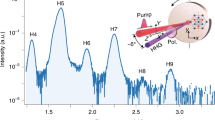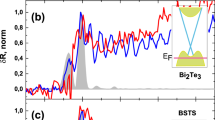Abstract
The prediction and realization of topological insulators have sparked great interest in experimental approaches to the classification of materials1,2,3. The phase transition between non-trivial and trivial topological states is important, not only for basic materials science but also for next-generation technology, such as dissipation-free electronics4. It is therefore crucial to develop advanced probes that are suitable for a wide range of samples and environments. Here we demonstrate that circularly polarized laser-field-driven high-harmonic generation is distinctly sensitive to the non-trivial and trivial topological phases in the prototypical three-dimensional topological insulator bismuth selenide5. The phase transition is chemically initiated by reducing the spin–orbit interaction strength through the substitution of bismuth with indium atoms6,7. We find strikingly different high-harmonic responses of trivial and non-trivial topological surface states that manifest themselves as a conversion efficiency and elliptical dichroism that depend both on the driving laser ellipticity and the crystal orientation. The origins of the anomalous high-harmonic response are corroborated by calculations using the semiconductor optical Bloch equations with pairs of surface and bulk bands. As a purely optical approach, this method offers sensitivity to the electronic structure of the material, including its nonlinear response, and is compatible with a wide range of samples and sample environments.
This is a preview of subscription content, access via your institution
Access options
Access Nature and 54 other Nature Portfolio journals
Get Nature+, our best-value online-access subscription
$29.99 / 30 days
cancel any time
Subscribe to this journal
Receive 12 print issues and online access
$209.00 per year
only $17.42 per issue
Buy this article
- Purchase on Springer Link
- Instant access to full article PDF
Prices may be subject to local taxes which are calculated during checkout




Similar content being viewed by others
Data availability
Data underlying the results presented in this paper are not publicly available at this time, but may be obtained from the authors upon request.
References
Zhang, H. et al. Topological insulators in Bi2Se3, Bi2Te3 and Sb2Te3 with a single Dirac cone on the surface. Nat. Phys. 5, 438–442 (2009).
Moore, J. E. The birth of topological insulators. Nature 464, 194–198 (2010).
Hasan, M. Z. & Kane, C. L. Colloquium: Topological insulators. Rev. Mod. Phys. 82, 3045–3067 (2010).
Roushan, P. et al. Topological surface states protected from backscattering by chiral spin texture. Nature 460, 1106–1109 (2009).
Baykusheva, D. et al. Strong-field physics in three-dimensional topological insulators. Phys. Rev. A 103, 023101 (2021).
Brahlek, M. et al. Topological-metal to band-insulator transition in topological-metal to band-insulator transition in (Bi1−xInx)2Se3. Phys. Rev. Lett. 109, 186403 (2012).
Salehi, M. et al. Finite-size and composition-driven topological phase transition in (Bi1−xInx)2Se3 thin films. Nano Lett. 16, 5528–5532 (2016).
Chen, Y. L. et al. Experimental realization of a three-dimensional topological insulator, Bi2Te3. Science 325, 178–181 (2009).
Xia, Y. et al. Observation of a large-gap topological-insulator class with a single Dirac cone on the surface. Nat. Phys. 5, 398–402 (2009).
Fu, L. Hexagonal warping effects in the surface states of the topological insulator Bi2Te3. Phys. Rev. Lett. 103, 266801 (2009).
Boolakee, T. Light-field control of real and virtual charge carriers. Nature 605, 251–255 (2022).
Xu, S.-Y. et al. Topological phase transition and texture inversion in a tunable topological insulator. Science 332, 560–564 (2011).
Wu, L. et al. Quantized Faraday and Kerr rotation and axion electrodynamics of a 3D topological insulator. Science 354, 1124–1127 (2016).
Ali, M. N. & Parkin, S. S. P. Butterfly magnetoresistance, quasi-2D Dirac Fermi surface and topological phase transition in ZrSiS. Sci. Adv. 2, e1601742 (2016).
Zhang, A. et al. Topological phase transition between distinct Weyl semimetal states in MoTe2. Phys. Rev. B 100, 201107(R) (2019).
Sobota, J. A., He, Y. & Shen, Z. X. Angle-resolved photoemission studies of quantum materials. Rev. Mod. Phys. 93, 025006 (2021).
Corkum, P. B. B. & Krausz, F. Attosecond science. Nat. Phys. 3, 381–387 (2007).
Itatani, J. et al. Tomographic imaging of molecular orbitals. Nature 432, 867–871 (2004).
You, Y. S., Reis, D. A. & Ghimire, S. Anisotropic high-harmonic generation in bulk crystals. Nat. Phys. 13, 345–349 (2017).
Lakhotia, H. et al. Laser picoscopy of valence electrons in solids. Nature 583, 55–59 (2020).
Vampa, G. et al. All-optical reconstruction of crystal band structure. Phys. Rev. Lett. 115, 193603 (2015).
Liu, H. et al. High-harmonic generation from an atomically thin semiconductor. Nat. Phys. 13, 262–265 (2017).
Luu, T. T. & Wörner, H. J. Measurement of the Berry curvature of solids using high-harmonic spectroscopy. Nat. Commun. 9, 916 (2018).
Bauer, D. & Hansen, K. K. High-harmonic generation in solids with and without topological edge states. Phys. Rev. Lett. 120, 177401 (2018).
Silva, R. E. F., Jiménez-Galán, Á., Amorim, B., Smirnova, O. & Ivanov, M. Topological strong-field physics on sub-laser-cycle timescale. Nat. Photonics 13, 849–854 (2019).
Chacón, A. et al. Circular dichroism in higher-order harmonic generation: heralding topological phases and transitions in chern insulators. Phys. Rev. B 102, 134115 (2020).
Bai, Y. et al. High-harmonic generation from topological surface states. Nat. Phys. 17, 311–315 (2020).
Schmid, C. P. et al. Tunable non-integer high-harmonic generation in a topological insulator. Nature 593, 385–390 (2021).
Baykusheva, D. & Ghimire, S. All-optical probe of three-dimensional topological insulators based on high-harmonic generation by circularly polarized laser fields. Nano Lett. 21, 8970–8978 (2021).
Hsieh, D. et al. Nonlinear optical probe of tunable surface electrons on a topological insulator. Phys. Rev. Lett. 106, 057401 (2011).
Vampa, G., Liu, H., Heinz, T. F. & Reis, D. A. Disentangling interface and bulk contributions to high-harmonic emission from solids. Optica 6, 553 (2019).
Neufeld, O., Podolsky, D. & Cohen, O. Floquet group theory and its application to selection rules in harmonic generation. Nat. Commun. 10, 405 (2019).
Yoshikawa, N., Tamaya, T. & Tanaka, K. High-harmonic generation in graphene enhanced by elliptically polarized light excitation. Science 356, 736–738 (2017).
Feng, Y. et al. Semiclassical analysis of ellipticity dependence of harmonic yield in graphene. Phys. Rev. A 104, 043525 (2021).
Baykusheva, D. & Wörner, H. J. Chiral discrimination through bielliptical high-harmonic spectroscopy. Phys. Rev. X 8, 031060 (2018).
Neupane, M. & Hasan, M. Z. Oscillatory surface dichroism of the insulating topological insulator Bi2Te2Se. Phys. Rev. B 88, 165129 (2013).
Sie, E. J. et al. An ultrafast symmetry switch in a Weyl semimetal. Nature 565, 61–66 (2019).
Hübener, H., Sentef, M. A., Giovannini, U. D., Kemper, A. F. & Rubio, A. Creating stable Floquet–Weyl semimetals by laser-driving of 3D Dirac materials. Nat. Commun. 8, 13940 (2017).
Jiménez-Galán, Á., Silva, R. E. F., Smirnova, O. & Ivanov, M. Lightwave control of topological properties in 2D materials for sub-cycle and non-resonant valley manipulation. Nat. Photonics 14, 728–732 (2020).
Acknowledgements
This work is primarily supported by the US Department of Energy, Office of Science, Office of Basic Energy Sciences, Chemical Sciences, Geosciences, and Biosciences Division through the AMOS program. Use of the Stanford Synchrotron Radiation Lightsource, SLAC National Accelerator Laboratory, is supported by the US Department of Energy, Office of Science, Office of Basic Energy Sciences under Contract No. DE-AC02-76SF00515. C.H. acknowledges support from the Humboldt Fellowship and the W. M. Keck Foundation. Y.K. acknowledges the Urbanek–Chorodow Fellowship from Stanford University. D.R.B. acknowledges support from the Swiss National Science Foundation (SNSF) through projects P2EZP2_184255 and P400P2_194343. D.J. and S.O. are supported by National Science Foundation’s DMR2004125 and MURI W911NF2020166. J.A.S., M.H. and P.S.K. were supported by the Department of Energy, Office of Basic Energy Sciences, Division of Materials Science and Engineering. Theoretical calculations were performed using the Sherlock HPC cluster at Stanford University. We thank Alexis Chacón and Fang Liu for fruitful discussions.
Author information
Authors and Affiliations
Contributions
C.H., Y.K. and S.G. conceived the project. C.H. and Y.K. designed the setup. C.H. and Y.K. performed the experiments and analysed the data. T.F.H., D.A.R. and S.G. supervised the project. D.R.B. developed the theoretical model and performed the numerical calculations. D.J. and S.O. synthesized and characterized the samples. C.H., M.H. and J.A.S. performed the ARPES measurements at SSRL. All authors contributed to the interpretation of data.
Corresponding authors
Ethics declarations
Competing interests
The authors declare no competing interests.
Peer review
Peer review information
Nature Nanotechnology thanks Dieter Bauer and the other, anonymous, reviewer(s) for their contribution to the peer review of this work.
Additional information
Publisher’s note Springer Nature remains neutral with regard to jurisdictional claims in published maps and institutional affiliations.
Extended data
Extended Data Fig. 1 ARPES measurements.
ARPES measurements of Bi2Se3 for 5 different indium concentrations.
Extended Data Fig. 2 Topological phase transition.
Ratio of HH yield for circular vs. linear excitation for various indium concentrations x. Measurements are performed at peak field E0 = 0.15 V/nm.
Extended Data Fig. 3 Transition from ordinary to anomalous ellipticity dependence.
a, b, c, Simulations of crystal orientation and MIR ellipticity dependent HH yield for three different field strength E0 = 0.06, 0.14, 0.25 V/nm. d, The ratio between HH obtained under circular and linear excitation for Φ= 0 is shown for various field strengths. The blue filled dots are the experimentally obtained values, the red line represents values from the simulation. The threshold field strength E0,threshold is defined when this ratio becomes 1. e, The threshold field scales inversely with the wavelengths.
Supplementary information
Supplementary Information
Supplementary Sections 1–7 and Figs. 1–5.
Rights and permissions
Springer Nature or its licensor holds exclusive rights to this article under a publishing agreement with the author(s) or other rightsholder(s); author self-archiving of the accepted manuscript version of this article is solely governed by the terms of such publishing agreement and applicable law.
About this article
Cite this article
Heide, C., Kobayashi, Y., Baykusheva, D.R. et al. Probing topological phase transitions using high-harmonic generation. Nat. Photon. 16, 620–624 (2022). https://doi.org/10.1038/s41566-022-01050-7
Received:
Accepted:
Published:
Issue Date:
DOI: https://doi.org/10.1038/s41566-022-01050-7
This article is cited by
-
Nonlinear optical diode effect in a magnetic Weyl semimetal
Nature Communications (2024)
-
Light control with Weyl semimetals
eLight (2023)
-
Giant room-temperature nonlinearities in a monolayer Janus topological semiconductor
Nature Communications (2023)
-
Emerging ultrafast techniques for studying quantum materials
Nature Reviews Materials (2023)
-
High-harmonic generation in CdTe with ultra-low pump intensity and high photon flux
Communications Physics (2023)



